When it comes to enchanting tales filled with wisdom, wit, and a touch of magic, Mrs. Darley's words stand out as true gems. Whether you're an avid reader of classic novels or a newcomer to timeless literature, her quotes offer profound insights and delightful musings that resonate across generations. Join us on this literary journey as we highlight a curated collection of the top 32 Mrs. Darley quotes, each one a testament to her enduring charm and sage perspective on life.
1. “We become paralysed with fear and guilt, obsessed by ‘labels’ and become unable to question the reasoning behind our beliefs or indeed realise that it is acceptable to challenge them. Sometimes we simply need to give ourselves permission to break free from the confines of the tribe and find our own way.” - Carole Carlton
2. “We feel safe on familiar ground, the tried and tested, the accepted, the so-called ‘normal’, but life is meant to be experienced and explored, to be a journey of self-discovery and adventure.” - Carole Carlton
3. “Listen,’ she whispered and pointed towards the window. ‘Whenever the wind blows from the east and the wind chimes dance in the moonlight, there is magic in the air.” - Carole Carlton
4. “Upon moving to Cornwall in 1991, I became bewitched by its enchanting timeless beauty, which captured my heart and holds me still. Brooding and mysterious, the south-eastern edge of Bodmin Moor provided the wild backdrop against which the introduction to my magical training and love of nature began.” - Carole Carlton
5. “My work as a Meridian Psychotherapist and Clinical Hypnotherapist has taught me that people often feel guilty about the way they feel or think and many do not realise that seasonal changes can have a profound effect on the psyche.” - Carole Carlton
6. “In truth, however, only four of the festivals celebrated by today’s followers of the seasonal wheel can definitely be attributed to the Irish and Scottish Celts, these being the quarter festivals of Imbolc, Lughnasadh, Beltane and Samhain, with the latter two being of the greatest importance.” - Carole Carlton
7. “Pagan paths, of which there are many, more often than not, are based upon an acknowledgement of a Divine presence within nature, as acknowledged by the pre-Christian peoples of these Islands and Northern Europe more than 1500 years ago.” - Carole Carlton
8. “So now, as the Maiden form of the Goddess whispers to us of hope and new beginnings at the festival of Imbolc, it is on a cold February morning that you are invited to step onto the ‘Wheel of the Year.” - Carole Carlton
9. “I have since learned that although the festival of Imbolc was far less romantic and far more practical to our Celtic ancestors than the initial image portrayed to me by Mrs Darley, it was no less magical, for it marked the beginning of the lambing season which to the Celts meant the difference between survival and extinction.” - Carole Carlton
10. “It is easy to see how the myths and legends which built up around the Goddess Bride became entwined with Christian doctrine, and there is one source which tells of St Brigid’s ale harvest being so abundant that enough ale was made to serve seventeen churches!” - Carole Carlton
11. “The Bronze and Iron Age peoples saw water as having supernatural powers whilst its dark mysterious depths were seen as the gateway to the underworld. People felt compelled to make offerings to the Deities, which they believed inhabited these magical places, as evidenced by many archaeological finds including jewellery, plaques, coins and both animal and human remains. No doubt these were the original ‘wishing wells’ that we throw our small change into today, in the hope that the spirit of the place will grant our heart’s desire!” - Carole Carlton
12. “Everyone looks for the first snowdrop as proof that our part of the earth is once more turning towards the sun, but folklore maintains that we should be wary of bringing them into the house before St Valentine’s Day, as any unmarried females could well remain spinsters!” - Carole Carlton
13. “Saturday morning brought an Imbolc gift of thick fog, as our select company of three set off onto the rain-sodden moor. ‘Here we are,’ said Mrs Darley, as the well appeared before us after a ten minute climb. She immediately began to unwrap a joint offering from Phyllis and herself of an ivy swag interwoven with white ribbons and laid it across the lintel of the well. I followed suit but with a far more modest bunch of pine branches and silver honesty.‘Drinks, dear?’ Mrs Darley looked at Phyllis, who right on cue produced three paper cups from her bag and filled them with whiskey from a hip flask.” - Carole Carlton
14. “Tea was the order of the day, neat for the hardened drinker or containing a tot of whiskey for those who liked it watered down! Throughout the afternoon, the wonderful aroma of rosemary wafted throughout the cottage and I later discovered that Mrs Darley sprinkled the dried herb on her grill pan and, with the grill on a low heat, it scented the whole cottage, bringing a feeling of warmth and security to us all.” - Carole Carlton
15. “Cleansing and clearing are two words which suit the essence of Imbolc, as this is February, the Roman month of purification. This can be a cleansing of the self, in undertaking a good ‘detox’, or a clearing and cleansing of the home, in keeping with the tradition of spring-cleaning.” - Carole Carlton
16. “The festival of the spring equinox speaks of freshness and youth, of excitement and endless possibilities. Nature begins to quicken and early flowers open to the warmth of the strengthening sun, bringing the colours of lemon and yellow into our lives on the wings of a March wind.” - Carole Carlton
17. “I nodded, appreciating the wisdom of her words.‘Yellow is the colour of early spring,’ she said, ‘just look at your garden!’ She gestured towards the borders, which were full of primulas, crocuses and daffodils. ‘The most cheerful of colours,’ she continued, ‘almost reflective in its nature and it is of course the colour of the mind.’‘That’s why we surround ourselves with it!’ laughed Phyllis, ‘in the hope that its properties will rub off.’‘Nonsense dear,’ said Mrs Darley dismissively, ‘Yellow light simply encourages us to think more positively. It lifts our spirits and raises our self-esteem in time for summer.’I immediately made a mental note to surround myself with the colour of the season and, like Phyllis, hoped that some of its properties would rub off on me.” - Carole Carlton
18. “The word ‘equinox’ simply means ‘of equal length’ and refers to the twelve hours of daylight and twelve hours of darkness at this point in the year. It was originally thought to stem from two Latin words aequus meaning equal and nox meaning night. The word ‘Vernal’, as this equinox is often called, is derived from the Latin word vernus meaning ‘of spring’.” - Carole Carlton
19. “Legend has it that during the festival of Eostre, all fires had to be extinguished in the Goddess’ honour and could only be relit from a sacred flame in the centre of the village. The new fire was seen as a symbol of sacredness and purity, something which everyone wanted to bring into their homes at such a lovely time of year when everything was fresh and new.” - Carole Carlton
20. “Strange as it may seem, the association of eggs and bunnies at Easter time are actually connected and, to discover more, we must once again turn our attention to the Saxon fertility Goddess, Eostre.” - Carole Carlton
21. “There is a delightful story which tells of Eostre finding an injured bird on the ground and, in order to save its life, she transformed it into a hare. The transformation however was incomplete and, although the bird looked like a hare, it still retained the ability to lay eggs. Regardless of this slight mishap, the hare was so grateful for the goddess saving her life that on Eostre’s festival the hare would lay eggs, decorate them and leave them as a token of thanks. In Germany today, many young children still believe that their Easter eggs are laid and delivered by the Easter hare.” - Carole Carlton
22. “The Green Man has also become synonymous with Cernunnos, the Celtic horned God, often portrayed in Celtic art as part man, part stag, who roams the greenwood wild and free. He is a character of strength and power, but often sadly mistaken for the devil by the Christian fraternity due to his horned appearance.” - Carole Carlton
23. “Horned humans are not unknown to medical science as there is a rare skin disease, which goes by the name of ‘Cornu Cutaneum’, a cutaneous growth, which resembles a horn and grows from the scalp.” - Carole Carlton
24. “The spring equinox celebration included a dawn trip to the nearby Rillaton Barrow, a Bronze Age burial mound high up on the Cheesewring Moor, with its entrance facing directly east.‘A great archaeological find, dear,’ Mrs Darley informed me, rather breathlessly, as we climbed up to the entrance. ‘A skeleton, dagger and gold cup were all found here. However, the gold cup ended up in the royal bathroom for some considerable time until the death of George V and now stands in the British Museum, although you can see a copy of it in Truro if you wish. Come,’ she said, patting the top of the lintel, ‘we’ll sit here a while and wait for the sun.’The sun duly arrived in all its spring glory over the eastern horizon, bringing a golden glow to the swathes of mist, which hung in the fields between Dartmoor and Bodmin.” - Carole Carlton
25. “We too can begin a new life, one that brings satisfaction and enrichment, whether this is by singing, dancing, running through the waves, walking barefoot on the grass or making love under the stars. Perhaps your dreams are greater than this, or perhaps more conservative, but whatever they are, Beltane is a wonderful time for expressing who you truly are.” - Carole Carlton
26. “In Cornwall, the long poles which marked the boundaries of the tin mines were crowned with St John’s Wort to ensure protection for the mine and its workers.” - Carole Carlton
27. “The summer solstice is a time for strength and vitality for action and movement.” - Carole Carlton
28. “In times when the grain was harvested by hand, many traditions and superstitions grew up around this important event.” - Carole Carlton
29. “We sang, we danced, we talked, we laughed, we ate, we drank, but most of all we shared our contributions and I learned, that Lughnasadh night, that true gifts come from the heart and not necessarily from the purse.” - Carole Carlton
30. “Making corn dollies under the watchful eye of Mrs Darley was an absolute must for all of us living in the tiny Cornish hamlet on Bodmin Moor.” - Carole Carlton
31. “Mrs Darley, I noticed, always had her corn dolly amidst an arrangement of cornflowers and poppies (albeit they were artificial!). The corn, I was to later understand, represented the God, the red poppies his sacrificial blood and the blue cornflowers his death and this is something I still adhere to today.” - Carole Carlton
32. “Nothing is ever lost as time passes, it merely metamorphoses into something as wonderful or, in some cases, into something even better than before.” - Carole Carlton








